The gadget provides large numerical displays so that the user will be able to sift through with relatively effortless ease. The entirety of the information presented is separated by light lines, something that will prove to be absolutely crucial in those stressful emergency situations. You can set the distinct audio alarms to go off in a variety of potentially dangerous scenarios.
The backlighting could use some improvement.
The model from Cressi Leonardo will easily be able to attract the kind of divers that don't just care about functionality and performance but would also like to acquire the sort of model that is as attractive and convenient as any sports watch out there.
RGBM + Deep Stop (optional)
Dive, Gauge, Watch
60 dives, 75 hours
~320 feet (100 meters)
3-year battery life (50 dives per year)
2 years (limited)
You will have the option of choosing between Pelagic DSAT (Spencer/Powell data basis) or Pelagic Z+ (Buhlmann ZHL-16C data basis). The underlying difference between the two is mostly that the former will give you a slightly longer NDL but also a more aggressive profile, while the latter will provide you with a safer ascent profile.
The instruction manual is somewhat underwhelming.
This oceanic dive computer will be a perfect fit for the most experienced diving enthusiasts. Though the price is a bit steep, the sheer number of functions and an interface that is both sophisticated and intuitive are more than enough to justify it.
Exclusive Dual Algorithm™ - Pelagic DSAT or Pelagic Z+
Watch, Norm (Air and Nitrox modes), Gauge, Free mode
up to 24 dives
~320 feet (100 meters)
300 hours
2 years
The same user-friendly interface is now part of the much larger Mineral Glass display that features a brighter backlighting and contrast compared to the previous iteration. If you're more of an experienced, free-spirited kind and you don't particularly care for alarms, warnings, or decompression calculations, you can use the Bottom Time mode that will display nothing but your depth, temperature, and time.
The battery doesn't always last as long as advertised.
The new model from Mares has been able to successfully build on the foundations of its predecessor. The new firmware is better than ever, both the display and the interface will be able to satisfy even the most demanding customers, and the model wouldn't lose to anyone in terms of functionality either.
RGBM
Air, Nitrox, Bottom time
35 hours
~500 feet (150 meters)
300 dives
2 years
The technologically advanced electronic 3D compass features a user-adjustable timeout, plus the model grants any future owners the ability to tilt the compass up to 45 degrees in any direction without impairing the ability to read figures clearly and accurately. There's also the wireless air integration option that will allow you to monitor tank pressure and air consumption.
Some elements of the menu are a tad counterintuitive.
If you're the kind of diver that doesn't just care to pad his stats by diving deeper and more frequently than the next guy and you would actually prefer to navigate through the water with efficacy and poise, there is no reason not to give the Suunto dive computer a whirl.
Suunto RGBM
Air, Nitrox, Gauge
36 hours
~320 feet (100 meters)
2 years (100 dives/year)
1 year
The product runs on the RGBM algorithm that, among other things, will prove to be the perfect fit for beginners since it is one of the more conservative algorithms out there with a large margin of safety. The Mares smart dive computer also features residual nitrogen reset, options to exclude both audible alarms and uncontrolled ascents. The ascent rate indicators are there and the whole thing is altitude adjustable.
Some models come with a dead battery.
The Mares 414117, also known as the Mares Puck, will prove to be a perfect fit for beginners that are interested in picking up scuba diving as a hobby or for experienced divers that would like to acquire a secondary dive computer watch.
RGBM
Air, Nitrox, Bottom time
40 hours
~500 feet (150 meters)
over 170 dives
2 years
This site is a free online resource that strives to offer helpful content and comparison features to its visitors. Please be advised that the operator of this site accepts advertising compensation from certain companies that appear on the site, and such compensation impacts the location and order in which the companies (and/or their products) are presented, and in some cases may also impact the scoring that is assigned to them. The scoring that appears on this site is determined by the site operator in its sole discretion, and should NOT be relied upon for accuracy purposes. In fact, Company/product listings on this page DO NOT imply endorsement by the site operator. Except as expressly set forth in our Terms of Use, all representations and warranties regarding the information presented on this page are disclaimed. The information which appears on this site is subject to change at any time. More info
Cressi Leonardo
Italian Elegance
A computer from Cressi Leonardo is the sort of model that combines the simplicity of cheaper gadgets with the renowned Italian elegance that manifests itself both through the model's design and functionality. Where some manufacturers often decide to ditch the looks and comfort in favor of functionality, the people behind this device seem to remember that dive computers are as much watches as they are computers, meaning they have to include the sort of properties that are usually found in regular watches.
The properties that we're talking about include but aren't limited to a long wristband that will accommodate wrists of all sizes and the sort of design choice that makes the model look as good as any sports watch out there.
However, this gadget is a dive computer first and foremost, and that means we're going to focus on the elements that are related to underwater diving, especially given that the device is absolutely no slouch when it comes to these elements. For starters, the model in question relies on RGBM as its algorithm. The latter, as some of the more experienced divers may already be aware of, is one of the most sophisticated algorithms out there that is based upon a number of complicated calculations, all of which lead to reduced no-stop time limits, safety stops in the 10-20 fsw (feet of sea water) depth zone, consistent diving protocols for altitude and a number of other measures and solutions. On top of that, this isn't just your run-of-the-mill RGBM but the one that comes with an optional deep stop feature, which is quite useful when it comes to preventing the formation of silent bubbles, the main culprits of post-dive fatigue.
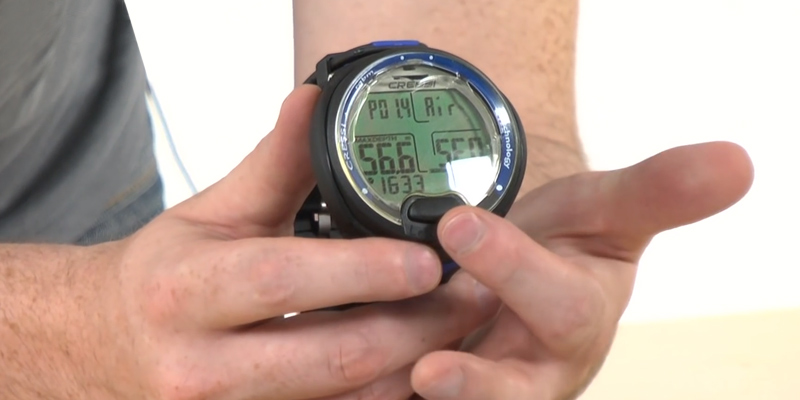
Navigate Through Settings
Moving on from the algorithms, it is important to talk about the display since a good display with an easy navigation system and user-friendly interface can make one of these gadgets just as much as the opposite will break them. Fortunately, this Cressi dive computer is as good of an example of the former as it gets, with a wide display that is incredibly easy to access and navigate through. It features complete Nitrox management, depth gauge mode, and a reset option.
Programming these modes won't prove to be an issue whatsoever thanks to a one-button interface that just about anybody will be able to figure out in a jiffy. Of course, given how much data you're going to be dealing with, it is just as important that the gadget provides large numerical displays so that the user will be able to sift through with relatively effortless ease. Furthermore, the entirety of the information presented is separated by light lines, something that will prove to be absolutely crucial in those stressful emergency situations. And, going back to the wrist dive computer's functions for a moment, we would be remiss not to mention the distinct audible alarms that you can set to go off in a variety of potentially dangerous scenarios.
In conclusion, the model from Cressi Leonardo will easily be able to attract the kind of divers that don't just care about functionality and performance but would also like to acquire the sort of model that is as attractive and convenient as any sports watch out there.
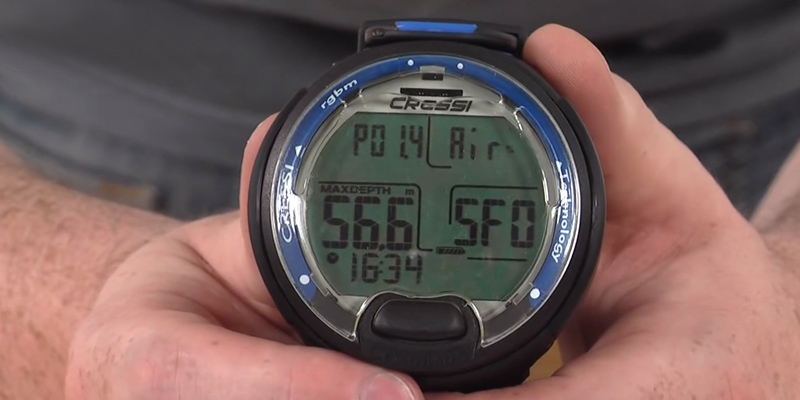
Additional Info
| Last updated price | $199.95 |
| Stock | In stock |
| ASIN | B018758S3A |
What customers say about this product
Key Specs
Features
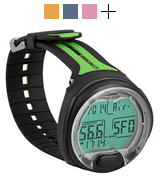
Oceanic Geo 2.0
Dual Algorithm
The Oceanic Geo 2.0 is certainly not the cheapest option out there and we probably wouldn't recommend it to beginners that are just getting started in the world of underwater diving. You don't get this kind of monstrosity if you're just learning the tropes unless you're willing to drop a few hundred bucks on a sophisticated piece of technology with lots of features that might just go over your head. This is a watch for people that know what they're doing, with years of experience under their belt and a deep passion for the sport.
Of course, these are just words, but what is it exactly that makes the model so attractive to the aforementioned crowd? Well, the fact that the model features an exclusive dual algorithm would certainly be a good place to start. You will have the option of choosing between Pelagic DSAT (Spencer/Powell data basis) or Pelagic Z+ (Buhlmann ZHL-16C data basis). While we wouldn't be able to explain every distinct element that separates these algorithms without going into some of the most complicated technical details, the underlying difference between the two is mostly that the former will give you a slightly longer NDL but also a more aggressive profile, while the latter will provide you with a safer ascent profile. Though we would like to emphasize that these are just vague estimations and you will have to figure out for yourself which of the two better suits your style and, therefore, your needs and preferences.
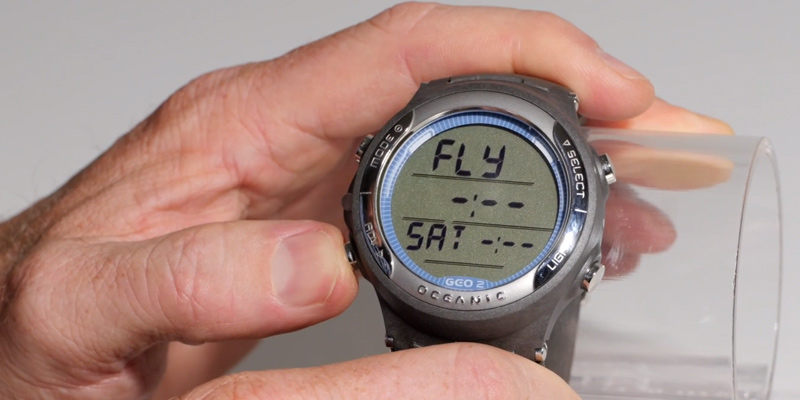
You're the One in Charge
While the dual algorithm setup is impressive on its own, the latter isn't even remotely the only thing that makes this Oceanic dive computer such a perfect fit for the experts. If you would like to know what else is there, we'd gladly point you in the direction of four operating modes that the model incorporates in order to accommodate the largest variety of diving enthusiasts. There's the Watch mode that includes alternate time, chrono, daily alarm, and a countdown timer. There's also the NORM mode, which is a combination of probably familiar to you Air and Nitrox modes. The gauge mode that adds a timer to the NORM is also there, along with the Free mode that works by tracking calculations in order to allow switching between NORM and Free. And if all of that is somehow not enough for you, the manufacturers also made sure to include the Deep Stop option that is quite useful when it comes to preventing post-dive fatigue.
Though the people at Oceanic don't really emphasize it too much, this dive computer watch is not the one to trail behind when it comes to interface either. With so many functions, it makes all the sense in the world that these people redesigned the already user-friendly interface of the model's predecessor by adding a step-back option that provides the user with an opportunity to navigate through the menus and settings both forwards and backward.
A few other things worth mentioning before we wrap this whole thing up is the construction of the watch that features an improved look with a stainless steel accent ring and an interface that allows the user to download and install updates on this thing via PC using the optional cable.
So, to reiterate a point that we made earlier, this oceanic dive computer will be a perfect fit for the most experienced diving enthusiasts. Though the price is a bit steep, the sheer number of functions and an interface that is both sophisticated and intuitive are more than enough to justify it.

Additional Info
| Last updated price | $289.95 |
| Stock | In stock |
| ASIN | B0037UVVZI |
What customers say about this product
Key Specs
Features

Mares Puck Pro
New Iteration of the Game Changer
Mares is a company that changed the dive computer's game back in 2008 when they introduced the original Puck computer to the mass market. Never before has the underwater diving community seen a full-featured RGBM nitrox computer that was so easy to use and came at such a competitive price. Now they're back at it again. While it sure wasn't easy to find some room for improvement in the original Puck, it would seem that the team of experts at Mares have been able to found a way or two.
Of course, before implementing new solutions, these people made sure to build on the success of the model's predecessor. So the intuitive and user-friendly interface is still there. You can still navigate through the whole thing and utilize all of its features by using a single button, even if you’re wearing thick dive gloves. And despite the simple interface, the manufacturers also made sure to add a fairly comprehensive user manual to the package in case you manage to run into some sort of issue with it.
However, the same interface is now part of the much larger Mineral Glass display that features a brighter backlighting and contrast compared to the previous iteration. That means the digits are a lot bigger now as well, so it will be really easy to sort through them even when you're deep underwater. To help you with that, the bright folk at Mares also separated these digits into three different sections, so sifting through information will now be easier than ever.

Choose Your Mode
In terms of functionality, this dive computer watch has more than enough to satisfy your average diving enthusiast. The whole thing runs on the RGBM (Reduced Gradient Bubbles Model) algorithm, which, as some of you may know, is arguably the most sophisticated and comprehensive solution out there when it comes to cutting down the formation of Micro-Bubbles without compromising dive times. And even though RGBM is already one of the more conservative algorithms, the mode will still allow you to adjust it to a more conservative diving profile, something that may prove to be useful for beginners or for those deep diving enthusiasts that like to go for multiple runs a day.
The three dive modes that were present in the previous Mares smart dive computer are making a comeback as well. In case you aren't familiar with them, there's the Air mode that people use when they dive with standard air, which is essentially identical to setting an EAN to 21% and a ppO2 max of 1.4 bar. There's also the Nitrox mode that will provide you with the option to dive with gas mixtures of EAN greater than 21%. Furthermore, you will now be able to use two gas mixtures during the dive. And if you're more of an experienced, free-spirited kind and you don't particularly care for alarms, warnings, or decompression calculations, you can use the Bottom Time mode that will display nothing but your depth, temperature, and time.
Besides functionality, the company also made sure to supply this wrist dive computer with an improved battery that should be able to live through over 300 dives. The depth limit has been extended to almost 500 feet (150 meters). Plus, the firmware has been upgraded as well.
All things considered, the new model from Mares has been able to successfully build on the foundations of its predecessor. The new firmware is better than ever, both the display and the interface will be able to satisfy even the most demanding customers, and the model wouldn't lose to anyone in terms of functionality either.
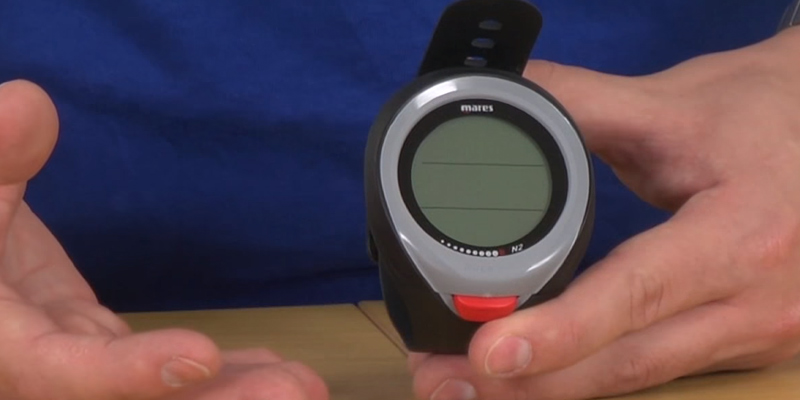
Additional Info
| Last updated price | $0.00 |
| Stock | May be out of stock |
| ASIN | B00OB5A4AQ |
What customers say about this product
Key Specs
Features
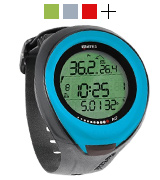
Suunto Vyper
Dive Like a Viper
The idea of giving a dive computer the same name as that of the venomous snake might seem a bit odd at first, we aren't going to lie, but if you know a thing or two about these creatures and if you spend enough time with this product, it will quickly dawn on you where the people at Suunto were coming from. You see, the pit viper hunts by using his heat-sensitive pits to locate the prey since the paired pit organs essentially provide the snake with thermal rangefinder capabilities.
Not entirely dissimilar to this dangerous creature, the model from Suunto features a couple of solutions that will allow the users to better navigate through the underwater world, providing them with the ability to dive with much more efficacy and poise. Though, when it comes to navigation, we simply wouldn't be able to overemphasize the importance of the Suunto dive computer's most exclusive and impressive element, which is the technologically advanced electronic 3D compass. In addition to featuring a user-adjustable timeout, the model grants any future owners the ability to tilt the compass up to 45 degrees in any direction without impairing the ability to read figures clearly and accurately.
Another aspect that makes this product what it is would have to be the wireless air integration option, which purpose is to provide the user with the opportunity to monitor tank pressure and air consumption right from the small little gadget tightly strapped to your wrist.
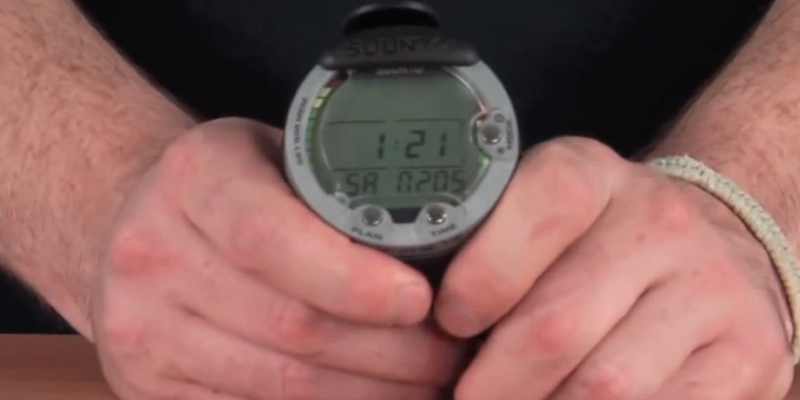
Navigate Through Water
Aside from the aforementioned functions, the Suunto dive computer offers just about the same options to its customer that you'll be able to find in any decent wrist computer out there. The model uses the Suunto version of the RGBM algorithm that comes with the Deep Stop function and ensures optimal ascent time with continuous decompression.
You can use the Gauge mode if you prefer to go diving knowing only the time and depth without relying on the computer to figure out the No Decompression Limit for you. And if you happen to be a less experienced diver or you simply don't feel like doing the calculations yourself, the standard Air and Nitrox modes will be able to help you out.
For those divers that often use enriched air, the wrist dive computer can be programmed in one percent increments for nitrox mixtures between 21 and 100% oxygen. Of course, we have already mentioned earlier the Deep Stop function, something that will protect deep diving aficionados with a series of prolonged breaks between the user's maximum depth and the ceiling.
Other than that, the standard automatic safety stop comes with a countdown, the battery is replaceable and the alarm clock is about as loud and clear as it gets.
All in all, the choice isn't actually quite as complicated as you would think. If you're the kind of diver that doesn't just care to pad his stats by diving deeper and more frequently than the next guy and you would actually prefer to navigate through the water with efficacy and poise, there is no reason not to give the Suunto dive computer a whirl.

Additional Info
| Last updated price | $453.85 |
| Stock | In stock |
| ASIN | B01DL7HDRG |
What customers say about this product
Key Specs
Features

Mares 414117
We Need to Go Deeper
Mares is one of the very few companies in the world of underwater diving that you can rely on to deliver when it comes to sophisticated high-end solutions just as well as when it comes to basic, affordable models that you can use as a substitute wrist computer or suggest to any individual that is just getting started as a scuba diver and is looking to acquire only the most essential pieces of diving equipment. And even though the model in question may be a bit basic, what it does have to offer will prove to be enough for your average diver and more than enough for a beginner.
First off, we would like to point out the fact that this Mares smart dive computer will be able to stay functional up to 492 feet (150 meters), which is more than impressive if you put its price tag into consideration. The logbook is capable of recording up to 40 hours of diving data, and that's the kind of numbers that are usually reserved for the more expensive wrist computers. And, sure, the model that is also known as the Mares Puck sure earns its name since the whole thing features just about 5 x 5 x 5 inches in overall dimensions, so you really wouldn't want to use it as a watch outside of your diving sessions. However, that size is somewhat justified by the fact that it was necessary to support a battery that will be able to live through over 170 dives and that, again, is quite impressive given that we're talking about an affordable entry-level wrist dive computer.
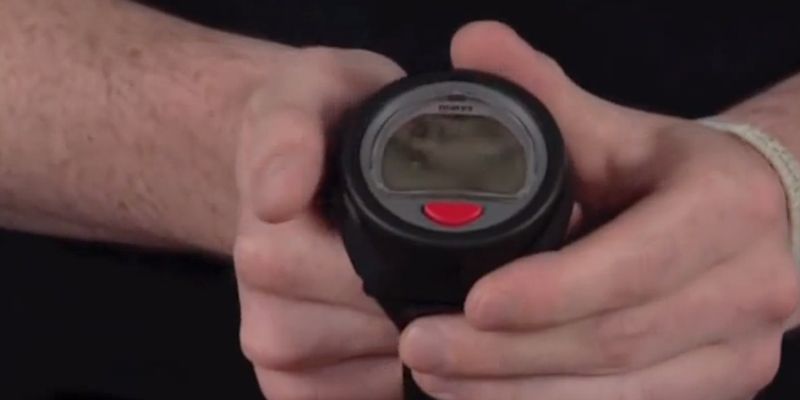
Safe Exploration
Since we're talking about a model that is best suited for beginners, the fact that the computer is incredibly easy to operate is arguably its biggest selling point. A single button is the only thing you will need to manage all of its settings. The digits do not lack in terms of size, so those with less experience will have to spend less time trying to make sense of them. Plus, the previously mentioned size of the model also provided the manufacturers with the opportunity to install a larger display, and that's never a bad thing as far as dive computer watches are concerned.
In terms of performance, the product runs on the RGBM algorithm that, among other things, will prove to be the perfect fit for beginners since it is one of the more conservative algorithms out there with a large margin of safety. Nevertheless, the manufacturers didn't forget about the more experienced divers that wouldn't mind to pick up this computer as a secondary option. For these skilled individuals, the model includes the Air and Nitrox modes. And, for the most seasoned divers, there's the Bottom Time mode that lets the user handle the calculations himself.
Finally, the Mares smart dive computer also features residual nitrogen reset, options to exclude both audible alarms and uncontrolled ascents. The ascent rate indicators are there and the whole thing is altitude adjustable. Other than that, the watch, date and temperature functions could certainly be compared to the surprisingly tasty cherry on top of an affordable cake.
With all of that out of the way, we feel inclined to paraphrase our earlier point, which was that the Mares 414117, also known as the Mares Puck, will prove to be a perfect fit for beginners that are interested in picking up scuba diving as a hobby or for experienced divers that would like to acquire a secondary dive computer watch.
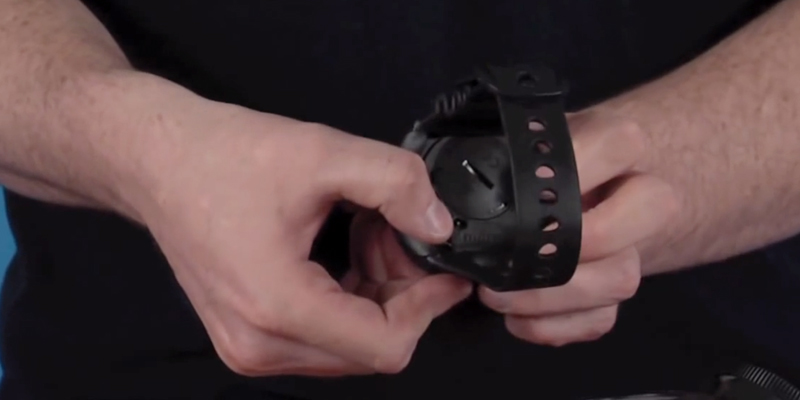
Additional Info
| Last updated price | $0.00 |
| Stock | May be out of stock |
| ASIN | B01JHPAVU2 |
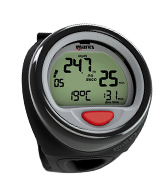
What Is a Dive Computer?
Diving is a fun activity, there's just no two ways about it. Combining the physicality of sports with the ability to observe and experience underwater life, it's no surprise that so many people choose diving as their pastime activity, with the most enthusiastic ones turning it into their profession or planning their vacations around it. However, it can also be an extremely dangerous activity under certain circumstances, which is why both those people that are serious about diving and amateurs that are just getting started in the world of diving prefer to gear up with a dive computer. Despite the suggestive name, a device like that is as much of a computer as it is a watch that you put around your wrist. Among other things, these useful gadgets measure the time and depth of a dive, allowing an individual to spend more time underwater without suffering the symptoms of what is known as a decompression sickness. They usually come with a selection of modes and settings that an underwater diver can tweak according to his personal needs and preferences.
And if underwater diving isn't really your thing, you can always pick up a new hybrid bike or get yourself a new tennis racquet and hit the courts.
What Features to Compare
Algorithm
The first and by far the most important thing you have to keep in mind when you go looking for a wrist computer is the kind of algorithm the model comes equipped with. In short, when it comes to these devices, an algorithm is a mathematic formula that works with real-time measurements of depth, gas mix, time at depth and, depending on the algorithm, a whole lot of other data in order to determine the amount of time you can spend underwater without running an increased risk of suffering the symptoms of the decompression sickness (colloquially known as the DCS). There are quite a lot of these algorithms out there given that the majority of companies tend to come up with different variations of their own take on the pre-established ones, but we can more or less divide them into two categories. The first one is usually being referred to as a more conservative one. The dive computers that use a conservative algorithm generally tend to lessen the risk or likelihood of DCS as much as possible by limiting the dive time. On the other hand, the more liberal algorithms will allow you to spend far more time deep underwater, but, as you would imagine, you will also be running an increased risk of DCS.
Modes
Even the least sophisticated dive computers out there come with a couple of modes that will allow you to adjust the settings according to your needs and preferences. Gauge mode, for instance, will only tell you the depth you are currently at and the amount of time you have spent there and it won't gauge your residual nitrogen levels. Dive mode (also known as Free or Free-dive mode), on the other hand, differs from a normal one in that it samples the data on a much more frequent basis, with some models updating information literally every second, a feature that will be incredibly useful for those audacious individuals that prefer to free dive.
Logbook and Depth Limit
Now, these two aspects are fairly simple and their name should probably already tell you what they stand for. If you're the type of person that goes diving on a frequent basis, you should go for the model that features the sort of logbook capable of recording and sorting through as much data as possible. And if you don't particularly care for those amateurs that swim around the coast and you're more of a deep diver yourself, you should make sure that the dive computer watch will be able to support your passion with a corresponding depth limit.
Battery Life
Again, this one is fairly simple. There's really no downside to having as much battery capacity as possible. Besides, the batteries aren't that expensive and most decent models nowadays come with the sort of batteries that will be able to last you for at least a year.
Did you know?
Very few people would be able to argue the fact that scuba diving is one of the most enjoyable and adrenaline-inducing recreational activities out there as you don't just get to observe all of the wonders of underwater life but also perform the sort of physical feats that are simply impossible for surface dwellers otherwise. And since this is a physical activity, it means there's also a slew of health benefits that come with it. Some of them are more or less obvious and expected, while others may even surprise the uninitiated kind. Without further ado, here are a few examples of the health benefits that we decided to share with you.
Physical Fitness
One of the most obvious ones but we still felt the need to at least brief touch upon the subject. As most of you probably know, swimming is one of the most effective aerobic and anaerobic exercises out there and swimming deep underwater is by no means an exception to this rule. Plus, it works both as a cardiovascular and muscular workout given that we swim against the natural pressure of the water without virtually any kind of strain to our joints. And since your muscles have to work harder underwater in order to overcome the water current, you don't just develop your endurance but also strengthen your muscles.
Breathing
In order to improve air consumption and increase the bottom time, i.e. the time you can spend deep underwater, a diver has to learn how to breathe in a slow and deep manner. However, this breathing technique is useful not only when it comes to underwater diving but is also very beneficial in everyday life. Slow and steady breathing reduces heart rate and that, in turn, leads to a calm attitude that you will find useful in a variety of mundane scenarios. Furthermore, this manner of breathing also decreases the chances of all kinds of lung-expansion injuries, not to mention the fact that it can help you with preexisting conditions like asthma.
Travel and Sunlight
Unless you happen to live next to an ocean, you will have to travel to a country with a much warmer climate in order to have the opportunity to dive deep underwater. And we all know the benefits of traveling, with some people willing to go as far as to claim that this is the best form of education. Naturally, you get to meet new people, visit new places, and experience different cultures. Besides, the people you'll meet will likely share a common interest with you, so may end up with a few new close friends at the end of your vacation. Aside from all of these benefits, warmer climate also means a lot more sunlight, and the latter carries with it an endless supply of vitamin D, this nice little vitamin that strengthens our bones and increases the endorphin production in the brain, something that results in a much healthier nervous system.
Reduced Blood Pressure
Since people mostly dive in the areas where the temperature of the water is much lower than the body temperature, our bodies compensate for the temperature loss by increasing the blood pressure for the first minute or two of the dive and then decreasing it once the body adjusts to the water temperature. That means that diving on a regular basis will reduce your blood pressure, and that, in turn, will decrease the chances of strokes and heart attacks.
FAQ:
Q: What does a dive computer do?
A: As we have briefly touched upon the subject earlier, a dive computer is essentially a sophisticated calculator that is one of the most important pieces of diving equipment due to the fact that it is capable of measuring and displaying a variety of complicated components and all kinds of pieces of useful information. But even though most middle- and high-end dive computers include all kinds of features, the most important one is an algorithm that calculates how much time one can spend underwater without suffering the adverse effects of deep diving. While each algorithm works in its own way, they all perform the latter task by calculating the time spent underwater and the depth of your dive. Aside from that, depending on the model, a device like that could tell you the temperature of the water, the compass direction, and some may even allow you to download the data that you have been logging from the device to a computer via Wi-Fi, Bluetooth, or cable.
Q: How to use a dive computer?
A: Well, even the most sophisticated dive computers aren't really the most complex pieces of information technology equipment out there. Nevertheless, there are still a few things you need to understand about them in order to utilize these gadgets in a proper manner. First, you will have to understand the definitions of the most important measurements. Hopefully, we don't have to explain what "depth", "temperature", and "air pressure" stand for. In addition to those, there's also the bottom time, which is a piece of data that tells you how much time you have spent at a particular depth.
Putting all of these things into consideration, the dive computer comes up with an acceptable No Decompression Limit (NDL). What NDL is is essentially a formula that suggests the amount of time you have left at your current level of depth. The formula is calculated based on how deep underwater you are at the moment, where you currently are, where you were when you initiated the dive, where you have been throughout the entire process and how much time you have spent there before incurring a mandatory decompression stop.
Knowing all of these, you should choose the model with the sort of algorithm that puts into consideration the diving conditions that you are facing at the time and how you feel physically. After that, unless you already have years of experience under your belt, you should set it to Air or Nitrox modes since these are the more conservative modes and the majority of recreational divers should always rely on them. With that out of the way, you also might want to set some sort of an alarm based on max depth or tank pressure or a safety stop that activates after you spend a specific amount of time at a certain level of depth.
Q: What should I do if my wrist computer suddenly stops working during a dive?
A: Don't be a hero and abort the dive. Also, make sure to regularly monitor your computer during the dive. Doing that, you won't be caught off-guard and you'll know where you stand in terms of decompression.
Q: Are these gadgets suitable for beginners?
A: These devices are ideal for beginners since they make it so much easier for you to dive relatively safely without having to do all the necessary calculations yourself.
Sources:
1. WHY TAKE A DIVE COMPUTER? SUUNTO. July 14, 2014.
2. Dive computer, Wikipedia.
3. Chantae Reden 35 AWESOME SCUBA DIVING TIPS FOR BEGINNERS, TheAdventureJunkies.
4. Natalie Gibb The Essential Gear for Scuba Diving, ThoughtCo. August 25, 2017.
5. Scuba Diving: Essential Things You Need To Bring, LeisurePro. September 26, 2017.
6. Edwin Thomas, Leaf Group What Are the Dangers of Scuba Diving? USAToday. March 15, 2018.
7. Scuba Diving, Wikitravel.
Popular Comparisons
































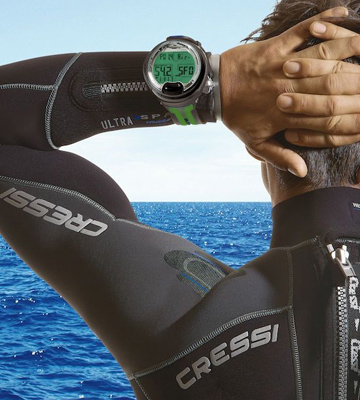

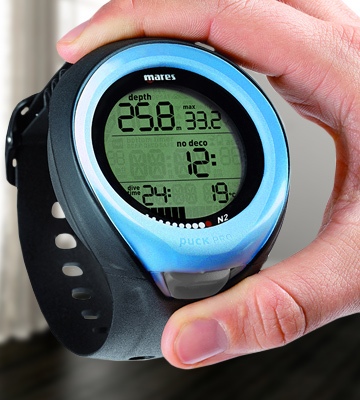


Your comment was successfully sent
Error! Please try again later